For me flight shots of Cooper’s Hawks are literally unheard of but yesterday morning I got four of them, plus photos of it taking off. They’re not perfect but I’m happy to have them.
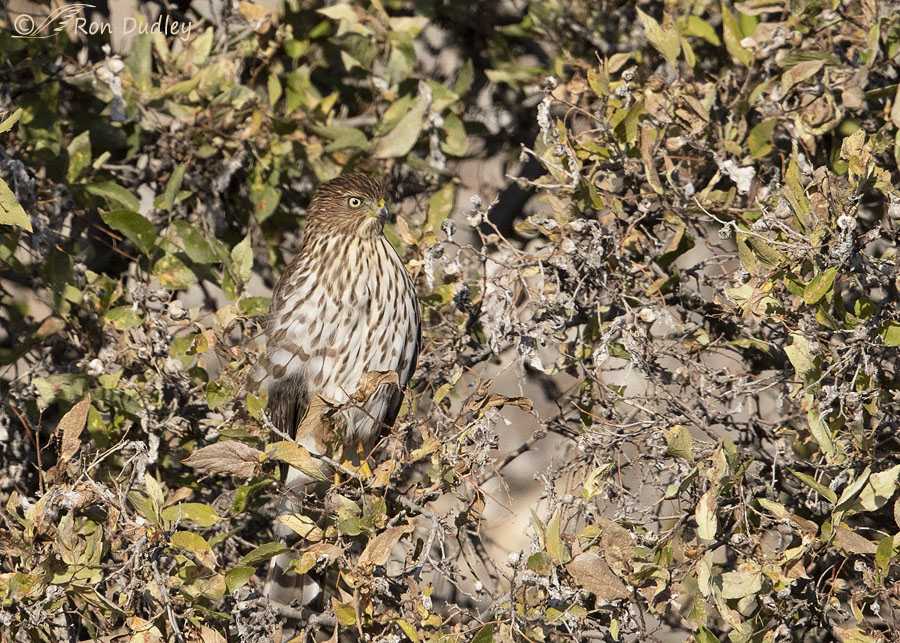
1/4000, f/7.1, ISO 800, Canon 7D Mark II, Canon EF 500mm f/4L IS II USM + EF 1.4 III Extender, not baited, set up or called in
And it wasn’t the same Cooper’s Hawk I photographed last week. I found this juvenile in extreme northern Utah and over 100 miles from the location of the previous hawk. Unlike the earlier very calm juvenile this one was high-strung and jumpy as hell which is more typical of the species. I can see the spookiness in its eyes.
“He” wasn’t very close but I kept my lens trained on him anyway to see if I might get a takeoff or flight shot. I got a bunch.
I’d estimate that Cooper’s Hawks are at least twice as fast as much larger Red-tailed Hawks during takeoff and in flight so in the past I’ve never had any luck with those kinds of shots of this species, none at all. Which is why I’m so pleased with these, despite the close, cluttered and not very attractive background.
Ok, let’s get on with it. All seven of the photos included in this post are sequential with no skips.
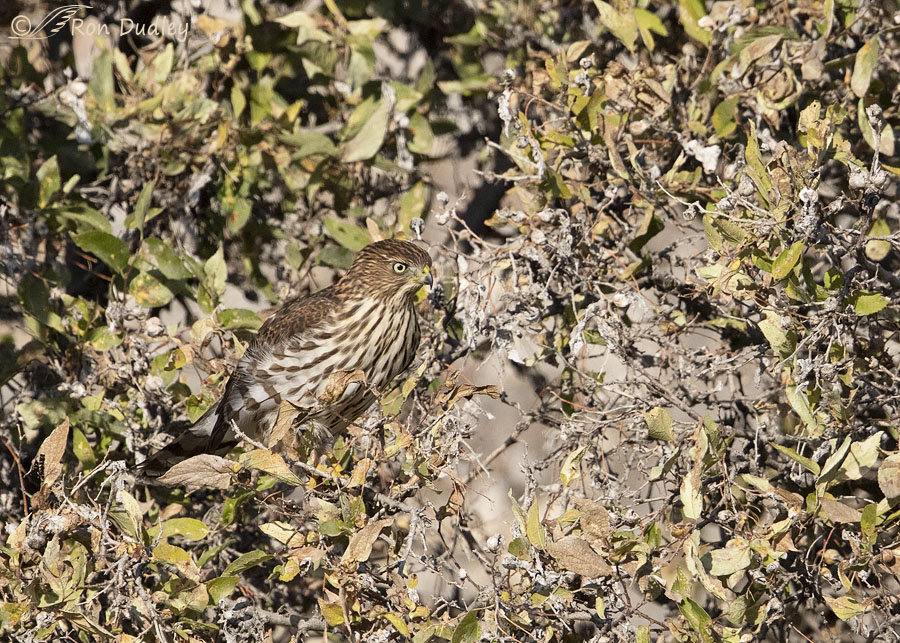
1/4000, f/7.1, ISO 800, Canon 7D Mark II, Canon EF 500mm f/4L IS II USM + EF 1.4 III Extender, not baited, set up or called in
Leaning into the takeoff. It was this “lean” that prompted me to begin firing my burst quickly enough to catch the launch. Without it I’m sure I’d have been too late.
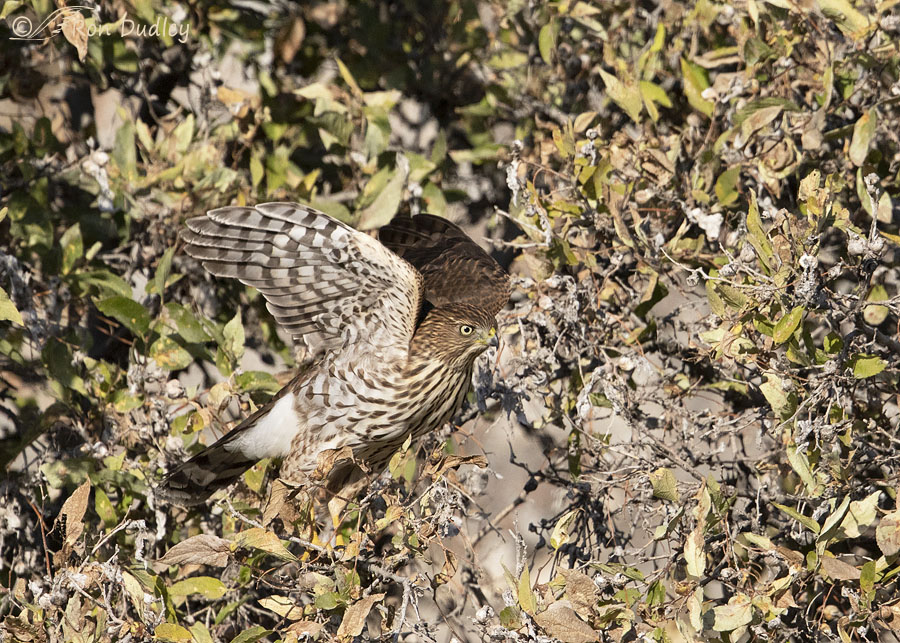
1/4000, f/7.1, ISO 800, Canon 7D Mark II, Canon EF 500mm f/4L IS II USM + EF 1.4 III Extender, not baited, set up or called in
Wings up and…
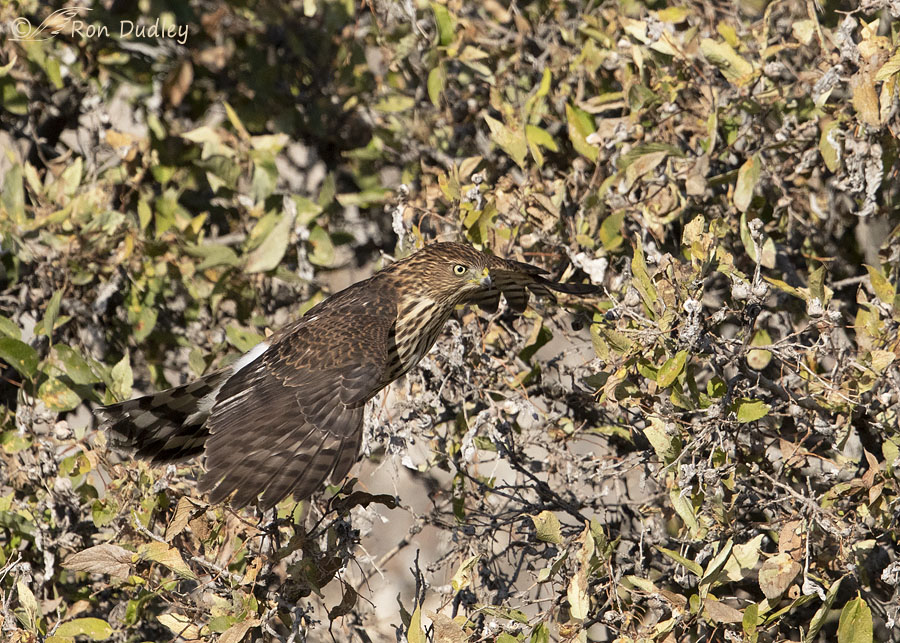
1/3200, f/7.1, ISO 800, Canon 7D Mark II, Canon EF 500mm f/4L IS II USM + EF 1.4 III Extender, not baited, set up or called in
we have lift-off.
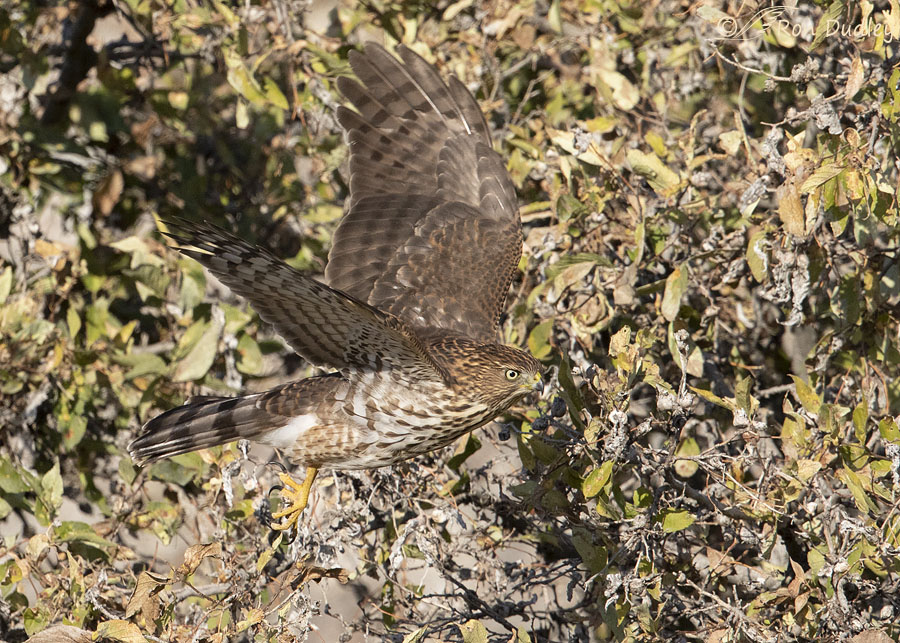
1/2500, f/7.1, ISO 800, Canon 7D Mark II, Canon EF 500mm f/4L IS II USM + EF 1.4 III Extender, not baited, set up or called in
I was just lucky that most of my photos caught the bird with its wings up or…
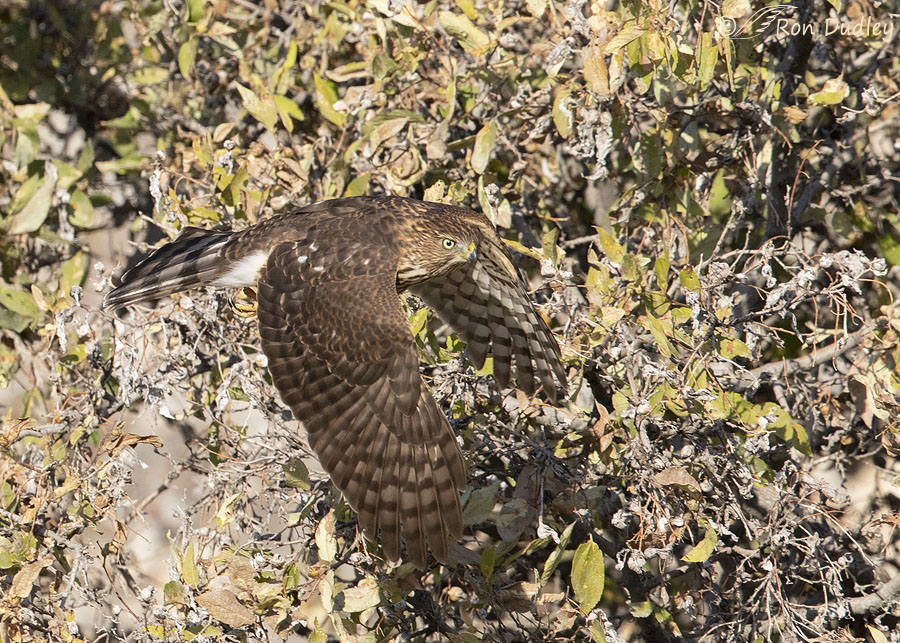
1/2500, f/7.1, ISO 800, Canon 7D Mark II, Canon EF 500mm f/4L IS II USM + EF 1.4 III Extender, not baited, set up or called in
down rather than in the less desirable horizontal position.
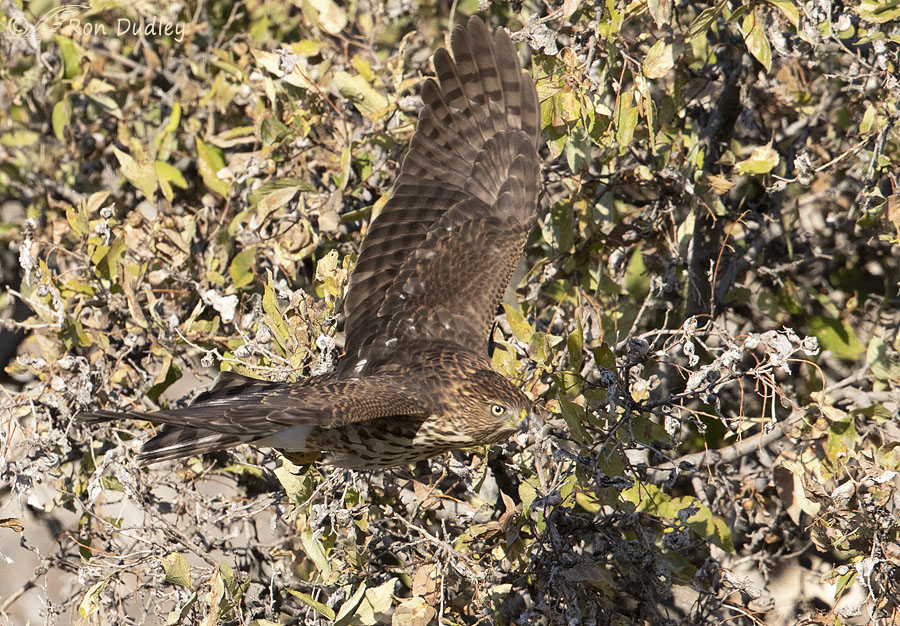
1/2500, f/7.1, ISO 800, Canon 7D Mark II, Canon EF 500mm f/4L IS II USM + EF 1.4 III Extender, not baited, set up or called in
In this last shot I nearly clipped a wing at the top of the frame so my composition isn’t ideal. I actually got two additional shots with the bird completely in frame but the hawk isn’t sharp enough in either one to include them here.
Yes, I absolutely do wish I had been a little closer to the hawk and that the background had been more attractive and further away from the bird. But these are my first decent shots of a Cooper’s Hawk in flight so getting them was a bit of a milestone for me.
Still a work in progress but at least it’s progress.
Ron


As with Alice (above comment) I follow daily in awe!
This is an awesome series… “Thank you” for sharing.
Ron, I wish that I always had great things to comment about your posts, but I don’t. I so much enjoy tuning into your daily blog. It brings me into a state of belonging. I am not as loyal as many of your readers in terms of making comments daily, but I always tune in to your daily blog and enjoy every minute of it. You have quite an interesting following. Thank you so much for your photos and your educational moments.
Alice
.
Don’t worry about how much you’re commenting, Alice. I’m just happy to know you’re enjoying my posts.
Very impressive, Ron! They are such feathered bullets. We have one nearby that regularly snags a big White-winged Dove out of the yard. I’ve only managed a few poor images. Sigh.
Thank you for showing us how it’s done!
The first time I photographed a Cooper’s with prey it was with a dove also. Pretty big prey for a bird this size but it was no problem at all for the Coop. Thanks, Wally.
Wonderful shots. They are so much fun to watch. Glad you had fun out there.
I did. Thank you, Jean.
I agree, the background sucks, BUT, you more than made up for it with these incredible take-off shots. Well done. Plus, I don’t know how you can tell it’s a Cooper’s and not a Sharp-shinned.
I struggle with telling them apart too, Lyle. Tail shape helps when you can see it. So does relative size. And then there’s the odds – I see far more Cooper’s than Sharpies.
I am not only impressed with you artistry and prose skills your eagle eye to find this beautiful bird in that busy background is admirable as well. Great stuff. Thanks for sharing.
Betty, at my age I’m not known for my eagle eye anymore. This bird was pretty easy to spot while it was flying and we could see about where it landed.
Congratulations!
Thanks, Sharon.
What Cooper’s Hawk??? Where???
🙂
Great camouflage in the first shot. I really like the “wings up” pre-takeoff shot! Glad you got some good ones!
Today’s Los Angeles Times has an article about declining bird populations “How Climate Change is Affecting Desert Birds.” (Sorry it is just the title, I couldn’t get the link thing to work.)
Me too, Marty. Not sure I can take reading any more bad news. Head in the sand, I know…
I am awed at ‘his’ camoflague. And loved this entire series. Isn’t all life a work in progress? At least you are moving in the right direction with these shots.
“Isn’t all life a work in progress”
I dunno, EC. Sometimes I regress… 🙂
That too is a form of progress. And you are not alone on the regression front.
The Maseratis of the hawk world. Well done, Ron. These guys are SO difficult to rehab; their maniacal nature makes it damn near impossible to contain one for 3-4 weeks as bones heal.
I’ve heard the same thing about rehabbing them, Leslie. I understand that’s one of the main reasons falconers tend not to even try to train them as falconry birds.
Lovely! Just lovely! But I’d guess that was a female. That’s just a GUESS, and probably even a WILD A$$ed GUESS!! I’m not good with Cooper’s and Sharpies 😉
Coops are DEFINITELY faster than redtails on takeoff and reaching top speed, however, redtails CAN do the same speeds when necessary. It’s just that the preferred Angel of Death strategy doesn’t require that kind of speed usually. Redtails are more like NASCAR stock cars (requiring momentum) while the accipiters are more like NHRA Top Fuel dragsters with that explosive initial speed. After all, they’re hunting small, flighty birds in the forest (or on bird feeders). They need that speed!
Thanks, Laura.
I’d have had to “wild-ass-guess” the sex of the bird too, which is why I used “he” in quotes, to let it be known that I really don’t know…
Wow, how in the world were you able to get and maintain focus with all that similar clutter in the background?!
I didn’t actively maintain focus, Kent, I didn’t even try.
I made a conscious decision to take my finger off the focus button once I’d focused on him perched. With the background so close I knew I had very little chance to keep focus locked on him after he took off so I decided to hope he’d take off to my right and stay in about the same focusing plane as when he was perched. Luckily he did.
But if I’d been much closer that technique wouldn’t have worked because my depth of field would have been too shallow to keep him sharp enough. I went to f/7.1 to give me just a little more wiggle room with depth of field.
It sure worked. I’ll have to try that. Thanks!
Wonderful! With skill and luck you really put it together for this series….:) The hawk still stands out VERY well against the cluttered background and wing position is beautiful. They sure blend in when perched! Another winter storm warning starting Tues. afternoon….. 🙁 At least it’s only for a day or so…….
Thanks, Judy.
I heard about your second snowstorm of the season coming in. I sure hope the farmers up north were able to get their crops harvested. But they didn’t have much time between storms…
Outstanding series Ron. The lean did it and you were ready and did not miss anything. I am always watching for those signs as I anxiously wait for one of our eagles to take off. And of course there are many misleading signs, but you have to continuously start that burst if you see what appears to be a lean. Love your humility, “Still a work in progress, but at least it’s progress.” Those words make amateur hobbyist photographers like me feel good.
“Love your humility”
I don’t know that that’s humility, Everett. It’s more like reality… 🙂
Well done Ron! I have a nice collection of photos of branches- they represent where the Coop was when I tried to get the takeoff shot! I also have a collection of tail feather shots where the rest of the Coop is out of the frame. At this rate, I anticipate having an actual takeoff shot by 2045!
Ha, I know the feeling, Diane. I have (or had) a bunch of both types of shots.
SENSATIONAL SERIES RON!!
CHARLOTTE
Thanks, Charlotte.
Focus, focus, focus, both for you and the hawk. Great series!
You got that right, Dick. It was pretty tense while I was waiting for him to take off with my finger on the shutter button. I knew I’d have to be fast…
Terrific! ❤️ You started your sequence at the right time for sure…such great wing positions. You really caught the separation of the feathers in all the wing shots; I really like the second to the last photo. I’m amazed you saw him buried in that background as you drove by. Whatever had his attention really kept him mesmerized…his gaze never wavered off point. Certainly is a milestone to celebrate.
Kathy, I’d never have seen that bird in the tree if I hadn’t seen him fly in that direction, looking like he was going to land there. He had obviously been hunting small birds confined to a fairly small area so that’s apparently what made him stick around when he flew the first time.
Beautiful Sequence Ron!
Thank you, John.